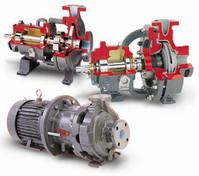 TRY TO INSTALL CONSTANT MONITORING. With proper instrumentation you can tell:
TRY TO INSTALL CONSTANT MONITORING. With proper instrumentation you can tell:
If the fluid in the stuffing box is about to change state and fail the mechanical seal. It could vaporize. It could solidify. It could crystallize. It could become viscous. It could build a film on the sliding surfaces and between the lapped faces.The differential pressure between the suction and the discharge can tell you how far you are operating the pump from its best efficiency point (BEP).
The suction pressure can tell you if cavitation is about to begin.Comparing flow to amperage can tell you if you need an impeller adjustment.Comparing flow to amperage can tell you if the wear rings need replacing. A probe in the bearing case or an infra red light can tell you if the bearing temperature is too high. A drop in capacity with no change in amperage consumption could tell you the open impeller needs adjusting.
GOOD MAINTENANCE PRACTICES
Be sure the pump and motor pedestal is at least five times the mass of the hardware sitting on it.Be sure there are ten diameters of pipe between the pump suction and the first elbow in the suction piping to prevent cavitation problems.Be sure piping reducers have not been installed upside down. They will trap air that will eventually enter the pump suction
Dynamic balance the rotating parts of the pump.
Do your pump to driver alignment at operating temperature.
Eliminate pipe strain.
Be sure the initial impeller adjustment is made at the pump operating temperature.
Be sure the vertical pump stuffing box is vented to a low point in the system.
Use suction recirculation for most seal applications.
Insure the bearing oil is being changed on a regular basis.
Insure that no water or solids are getting into the bearing case. Replace the grease or lip seals with labyrinth or positive face seals.
Stagger pipe hangers.
Do not use hardened shafts, the seal set-screws can slip.
GOOD OPERATING PRACTICES WILL LOWER MAINTENANCE PROBLEMS
Do not pump the supply tank dry.
Be sure the tank vent is clear and will not freeze in cold weather.
Run as close as possible to the pump B.E.P. You may have to reduce the impeller diameter to do this.
Be sure to keep any environmental controls functioning when the pump is stopped.
Remember that constant running is easier on bearings and seals.
RECOMMEND SENSIBLE DESIGN FEATURES TO LESSEN MAINTENANCE PROBLEMS
Make sure that the pump shaft L3/D4 is less than 60 (2.0 in the metric system).
Use the double volute design whenever possible.
Be sure the suction specific speed number is less than 8500
Specify a C or D frame adapter.
Specify a Centerline design pump.
Look for designs that adjust the open impeller from the wet end of the pump.
Specify a positive bearing retention method. A simple snap ring is not good enough.
Specify face seals for the bearing case, with an expansion chamber installed on the bearing case vent.
Install a sight glass or dip stick to check the oil level in the bearing case.
Do not use grease fittings on the bearing housing. If you are going to use grease, hand pack the bearings.
Use only a solid pump shaft for mechanical seals.
Specify a duplex metal for impellers to get the combination of wear and corrosion resistance.
Be sure there is adequate N.P.S.H. for the application.
Specify the large diameter stuffing box for mechanical seals. Do not use tapered versions.
Select the correct diameter impeller to stay within 10% of the best efficiency point.
Be sure the impeller to cutwater clearance is no less than 4% of the impeller diameter to avoid cavitation problems.
IF YOU MUST OPERATE OFF THE BEP
Stabilize the shaft
Be sure the shaft L3/D4 is less than 60 (2.0 in the metric pumps).
Try to specify as double volute if possible.
Stabilize the shaft with a suitable non sparking bushing
Move the seal close to the bearing. You can do this with a stuffing box extension.
Provide bearing oil cooling if the application is hot and you are concerned about soak temperature through the shaft.
Watch out for cavitation problems if you are operating on the high capacity side of the pump curve.
Throttle only the discharge side of the pump, never the suction side unless you are certain that the extra heat caused by discharge throttling will flash the product.

